


Axolotls exhibit neoteny, meaning that they reach sexual maturity without undergoing metamorphosis. Many species within the axolotl's genus are either entirely neotenic or have neotenic populations. The genes responsible for neoteny in laboratory animals may have been identified; however, they are not linked in wild populations, suggesting artificial selection is the cause. In this way, salamanders can reproduce and survive in the form of a smaller larval stage, which is aquatic and requires a lower quality and quantity of food compared to the big adult, which is terrestrial.